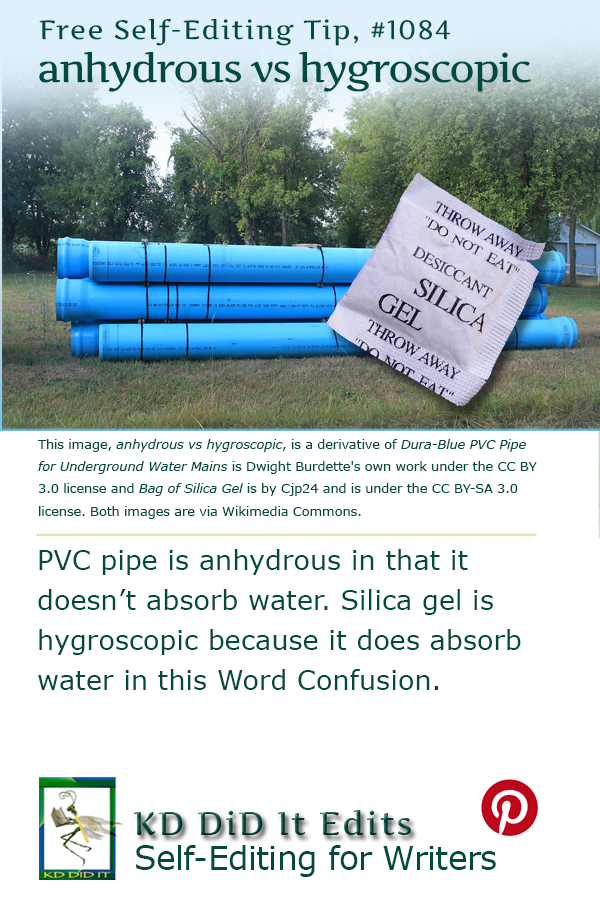Anhydrous versus hygroscopic are the antithesis of each other.
Anhydrous is a chemical compound without water molecules.
Hygroscopic is a chemical compound composed of water molecules.
Word Confusions . . .
. . . started as my way of dealing with a professional frustration with properly spelled words that were out of context in manuscripts I was editing as well as books I was reviewing. It evolved into a sharing of information with y’all. I’m hoping you’ll share with us words that have been a bête noir for you from either end.
If you found this post on “Anhydrous versus Hygroscopic” interesting, consider tweeting it to your friends. Subscribe to KD Did It, if you’d like to track this post for future updates.
| Anhydrous | Hygroscopic |
|---|---|

Iron (II) chloride anhydrate is Leiem‘s own work and is under the CC BY-SA 4.0 license, via Wikimedia Commons. — An example of anhydrous iron. |

Tillandsia macdougallii is Tim Stolten‘s own work and is under the CC BY-SA 3.0 license, via Wikimedia Commons courtesy of the Botanical Gardens of Heidelberg, Germany. — Air plants are hygroscopic. |
| Part of Grammar: | |
| Adjective | Adjective |
| [Chemistry & Geology; of a substance, especially a crystalline compound] Containing no water | [Of a substance] Tending to absorb moisture from the air
|
| Examples: | |
| Anhydrous ammonia is a gas or compressed liquid form of ammonia that contains no water.
Anhydrous ammonia is used in fertilizer. The sample was maintained at room temperature for 24 hours to ensure conversion of any anhydrous cholesterol crystals to the monohydrate form. The water in the mantle may be contained either in high pressure hydrous phases, or alternatively as small hydrous defects in nominally anhydrous minerals. |
Concrete is a hygroscopic material because it absorbs moisture from vapor and liquid sources.
Gases and non-aqueous liquids can be dehydrated by passing them over or through a hygroscopic substance, one that readily absorbs water. The main advantages of using hygroscopic dilators include outpatient placement and no FHR-monitoring requirements. The capsule is somewhat hygroscopic, and thus the size of the opening is dependent on relative humidity. |
| Derivatives: | |
| Adjective: nonhygroscopic Adverb: hygroscopically, nonhygroscopically Noun: hygroscopicity |
|
| History of the Word: | |
| Early 19th century from the Greek anudros from an- (without) + hudōr (water) + -ous. | First recorded in 1765–75, as hygroscope + -ic |
C’mon, get it out of your system, bitch, whine, moan . . . which words are your pet peeves? Also, please note that I try to be as accurate as I can, but mistakes happen or I miss something. Email me if you find errors, so I can fix them . . . and we’ll all benefit!
Satisfy your curiosity about other Word Confusions on its homepage or more generally explore the index of self-editing posts. You may also want to explore Book Layout & Formatting Ideas, Formatting Tips, Grammar Explanations, Linguistics, Publishing Tips, the Properly Punctuated, Writing Ideas and Resources, and Working Your Website.
Resources for Anhydrous versus Hygroscopic
Apple Dictionary.com
Dictionary.com: hygroscopic
Lexico.com: anhydrous, hygroscopic
Pinterest Photo Credits:
Bag of Silica Gel is Cjp24 is under the CC BY-SA 3.0 license and Dura-Blue PVC Pipe for Underground Water Mains Dwight Burdette‘s own work is under the CC BY 3.0 license. Both images are via Wikimedia Commons.


